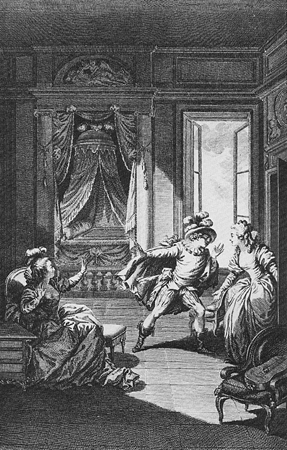
The
Closet Scene (St.-Quentin, 1785)
Pierre-Augustin Caron de Beaumarchais’s masterpiece, La Folle journée, ou le Mariage de Figaro (The Crazy Day, or the Marriage of Figaro), swirled in controversy during the earliest years of its existence. Though the playwright wrote this sequel to The Barber of Seville during the period 1775-1778, it was not until 1784 that the Parisian censors permitted its performance at the Comédie-Française. During the politically volatile years just before the French Revolution, the play aroused governmental anger not only by its outright calls for social equality, but also for the contempt with which persons of noble birth were treated: servants were more clever and humane than the aristocracy they served. Furthermore, the character of Figaro could be downright insolent, occasionally even venting his anger directly to the Count’s face.
When the play finally reached the Comédie-Française, the leading French theater found further problems with it. The ardently feminist character of Marceline (who was to become Marcellina in the opera) so disconcerted the company’s male administrators that they deleted her most virulent speech from the first production, declaring that no actress in Paris was capable of portraying the breadth of emotions that the monologue demanded.
Although Parisian opera companies of the late eighteenth century generally refused to mount operas by foreign composers who did not reside in Paris, in 1792 the directors of the Paris Opéra decided to make an exception for Figaro in order to honor the recently deceased composer and to take advantage of the immense popularity of the play. A real problem existed, however. The Revolution was now in full swing, but the opera had excised many of those criticisms of the aristocracy which the public would be expecting. Thus, the decision was made to amalgamate the opera and the play. While the set numbers (the arias, ensembles and choruses) were to remain, the recitatives were to be discarded in favor of the analogous portions of the play and the revolutionary diatribes were to be restored. In short, Mozart’s charming opera buffa was to be transformed into a hard-hitting French opéra-comique, a hybrid of the play and the opera.
Beaumarchais himself was eventually given the task of deciding which portions of his play were to be restored, and it is not surprising that he suggested almost everything! Furthermore, the wedding scene of the third act was expanded to include extra ballet music by Antoine Baudron, the concertmaster of the Comédie-Française, as well an aria from Don Giovanni for Figaro and one from Così fan tutte for Susanna (with new French text). During rehearsals early in 1793, entire scenes and even some of the set numbers were cut in an effort to bring the production back to a reasonable length.
I have collaborated with Miriam Ellis, a colleague in the French Department at UCSC, to create an edition in English that translates the recitatives from Beaumarchais’s original French and the set numbers from Da Ponte’s Italian libretto. In addition, we have restored some of the play’s anti-aristocratic dialogue and Marcellina’s feminist speech that Da Ponte never used for the libretto. We have also provided substitute spoken dialogue from the play for each set number so that the directors of a production can easily choose how much dialogue and how much music to perform. Since the edition can yield extremely diverse results, we have called it The Flexible Figaro. Further information about this edition may be obtained by contacting me at sdudley@cats.ucsc.edu or Miriam Ellis at ellisan@cats.ucsc.edu.
Further background information will be found in my article, "The First French Production of Mozart’s Marriage of Figaro" in The Opera Journal, vol. XXXII, no. 4 (December, 1999).